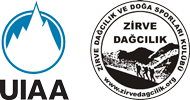| GERİ | Paylaş | 615 |
Spotting and belaying at the start of the route
Bu makaleyi çevirerek ülkemizde ki sınırlı kaynakları geliştirmek adına bize yardımcı olabilirsin. Yapacağınız çeviriler iletişim bilgilerinizle beraber yayınlanacaktır.
Bize ulaşın lütfen.
Spotting can help reduce the consequences of a fall in the first few meters of a climb, before the climber has clipped the first protection point.
Warnings
- Read the technical notice before viewing the following techniques.
- It is important to fully understand the information provided in the technical notice before using this complementary information
- Mastering these techniques requires training.
- Consult a professional before attempting to perform these techniques on your own.
Spotting is not about catching the climber. It's about guiding the climber's movements so that s/he lands in a good location and does not flip over backwards in a fall.
The spotter's technique must be adapted to the height and size of the climber. Generally the spotter's hands aim for the pelvis and the top of the climber's back, which are the key points for the climber's safety.

The belayer should spot until the first point is clipped. During this phase, the rope and belay device are already installed, with enough slack for the climber to clip the first point.
Once the first point is clipped, the belayer assumes a normal belaying stance.


To reduce the risk of groundfall:
The belayer must be close enough to the wall to minimize the amount of rope between him/her and the climber.
To avoid a collision in case of a fall:
The belayer must correctly visualize the trajectory of the route to avoid being below the climber. Position the rope so that it doesn't hinder the climber. Because the belayer is close to the wall and to the climber, the rope often gets caught in the climber's feet or interferes with the next clip. By being mobile and engaged, the belayer can make things go a lot easier in that moment.

Kanala abone olmak için
Hedef 200 eğitim videosu
Tırmanış konusunda her hafta yeni bir bilgi için abone olun

